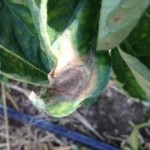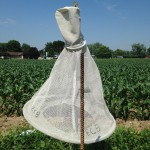Fruit:
Overall both apples and peaches are still looking good although scouts did note a large increase in both European red mites and 2-spotted spider mites on some varieties of apples the last couple of weeks. Populations were large enough that miticide treatments were recommended. Some traps for oriental fruit moth(OFM) had higher moth captures, indicating that we probably have second generation OFM so a biofix date will be set and growing degree days will be tracked to determine when insecticide applications should be made to peach trees.
In the small fruit area strawberry harvest has ended, and growers will need to start thinking about renovation in fields that will be kept for next year production. Some red raspberries and black raspberries are beginning harvest, and some blueberry varieties also have ripe berries. Birds are already working on some of the ripe blueberries. Grapes are developing fruit which are approximately pea-sized to a little larger at this point. Japanese beetles are showing up in grapes but any damage is below threshold at this point. Scouts are monitoring and trapping for spotted wing drosophila fruit flies and all trap counts are negative at this point.
Vegetables:
Recent rainfall events have caused ponding in some areas of fields and lots of areas of wet, saturated soils. As a result scouts are seeing yellowing of plant leaves, damping off, and some dying plants. While diseases were very minimal in most vegetable fields through mid-June, the rains and higher temperature and humidity since then has kicked off some disease cycles and scouts are noting more incidences of disease during the scouting week beginning June 22. Sally Miller’s announcement of downy mildew being found in SE Michigan on June 22 triggered an advisory to begin a protectant fungicide spray program on cucumbers and melons.
Tomatoes are ripening and harvest is underway in some high tunnels, but some growers need to work on opening up the tunnel to get more air movement and to reduce some of the high relative humidity that can be present. Scouts have noted leaf mold, early blight, sclerotina timber rot, blossom end rot and yellow shoulder in high tunnel tomatoes. The first diagnosis of bacterial spot in high tunnel tomatoes was made this week. Scouts also found some evidence of stink bugs, seeing stings on tomato fruit. (See photo below)
Field grown tomatoes are at flower and fruit set. Until the week of June 22 no diseases had been found by scouts in field tomatoes, however that has changed and scouts reported plants in some fields with symptoms of septoria leaf spot, early blight, and bacterial spot and possible bacterial canker.
Onions and garlic are developing well in the majority of fields. Scouts have found yellow strip virus, a potyvirus, in garlic. A couple of onion fields have some purple blotch (alternaria), while thrips have remained below treatment threshold level, possibly due at least in part to all the rainfall events. Cole crops look good overall, although a few fields are at threshold level for imported cabbage worm larvae and need to be treated.
Green snap beans are at a range of development stages as staggered planting continues. Some early plantings are just at harvest ready. Common pest problems include, bean leaf beetle leaf feeding, flea beetles, potato leaf hoppers and Japanese beetles. Currently all pests are below threshold levels. Eggplant and pepper plantings were doing well, but some saturated soils may change that status over the next couple of weeks in some fields. Scouts did note Colorado potato beetle feeding on some eggplant at threshold level. Some peppers have fruit with symptoms of blossom end rot and there is some leaf spot showing up on some plants as well.
Sweet corn is another crop at various development stages due to staggered planting and growth stages range from V-2 to tassel and silking. Both corn earworm and European corn borer moths are being caught in pheromone traps. Corn earworm moth numbers are low, 2-3/trap while corn borer moth counts ranged from 0 to 15/trap. European corn borer larvae feeding damage and larvae are being found, and with some fields at tassel and silking stage, the threshold level of damage has been reached and growers have been advised to spray. Japanese beetles and corn rootworm beetles are also present, currently at low levels in some fields.
As mentioned at the beginning of this report, cucumber and melon growers are being advised to start a protectant fungicide spray program against downy mildew. Other diseases that have shown up in vine crops include angular leaf spot, anthracnose and alternaria/target spot. Some water logged fields have plants dying back due to wet soils. Growers have treated for cucumber beetle pressure in squash, pumpkins, zucchini and melons and treatment has been effective as scouts have noted the presence of dead beetles. Other fields have reached threshold level and will need to be treated.
Many potatoes are in flower and tuber development. (See photo below) Colorado potato beetles is at or above threshold levels in some fields and in others control treatments have been successful in bring beetle numbers down. Potato leaf hopper numbers have remained low. Other insects noted at low levels in potato fields include flea beetles and tarnished plant bugs. In a few fields scouts have found some plants with black leg.
Agronomic Field Crops:
Corn is at a range of maturity stages and in some fields that were planted on the same day there is a range in corn height, much of which can be attributed to drainage or lack of drainage and wet soils. A lot of corn is in the v-8 to v-11 growth stage, corresponding to growth stages when the requirement for nitrogen increases. Along with that, scouts did note some yellowing of bottom leaves of corn. Plants that are short of nitrogen and that need nitrogen for growth will pull nitrogen out of lower leaves and use it for new growth. Nitrogen shortage in some fields could be attributed to nitrogen loss over the past couple of weeks due to rain and wet soils resulting in nitrogen leaching below the root zone and/or denitrification of nitrogen and loss into the atmosphere. (See photo below)
Scouts are noting low levels of corn borer larvae leaf feeding damage along with low levels of Japanese beetles, tarnished plant bugs and some slugs. Disease-wise, grey leaf spot was noted at low levels in some fields.
In soybeans wet soils are causing plants to yellow and in some areas where plants were submerged, there is plant death. Soybeans range from v-4 to R-l growth stage. Bean leaf beetle, grasshoppers and Japanese beetles are all doing some leaf feeding but all damage remains below treatment threshold levels. Scouts did find some brown spot and some possible bacterial leaf disease in soybeans this week. Damage to stands is also being caused by deer and groundhog feeding.
Rain has hampered second cut harvest of alfalfa. Once that happens, scouts will be monitoring for potato leaf hoppers.












